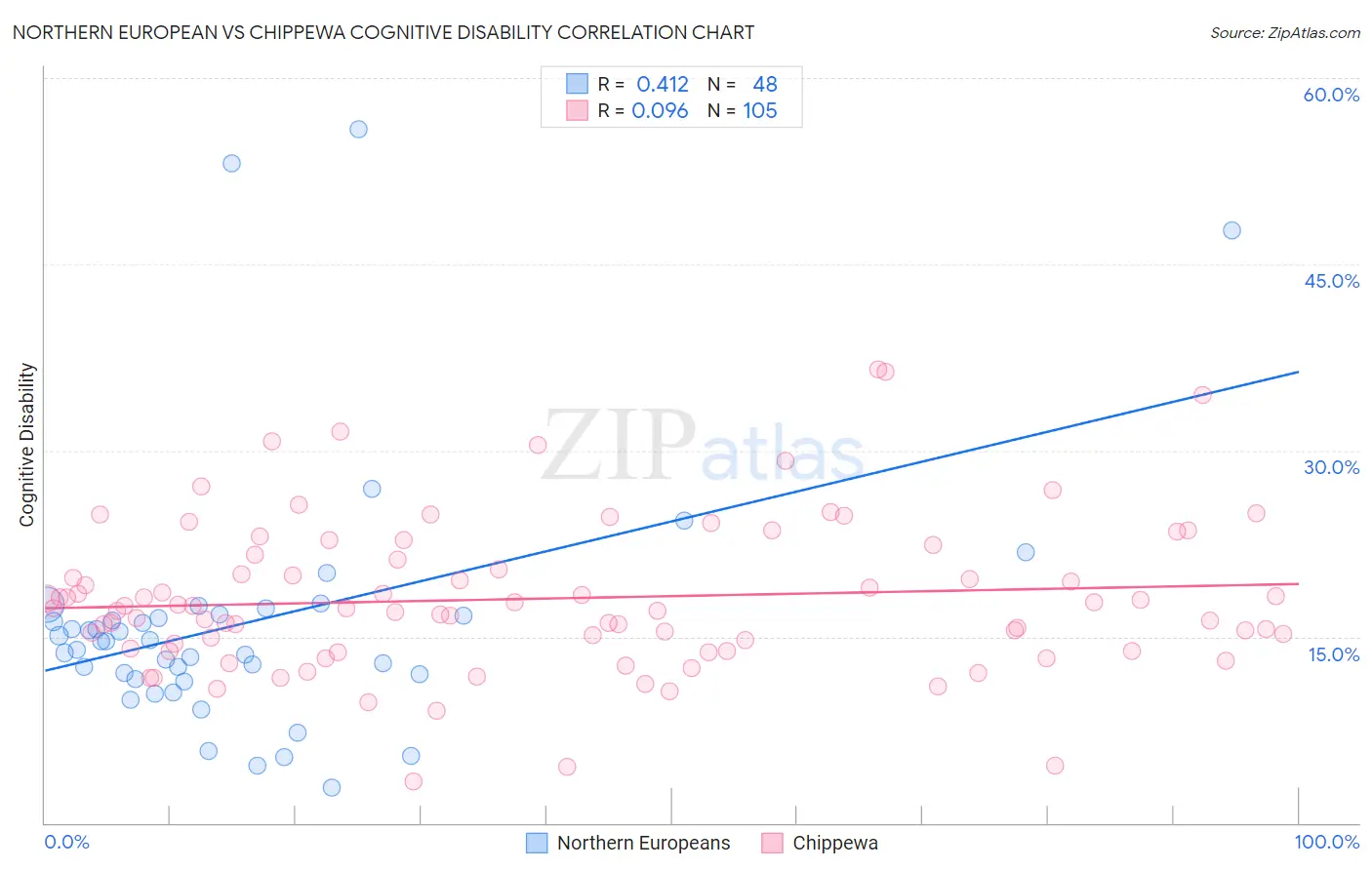Northern European vs Chippewa Cognitive Disability
COMPARE
Northern European
Chippewa
Cognitive Disability
Cognitive Disability Comparison
Northern Europeans
Chippewa
16.8%
COGNITIVE DISABILITY
97.8/ 100
METRIC RATING
106th/ 347
METRIC RANK
18.1%
COGNITIVE DISABILITY
0.1/ 100
METRIC RATING
279th/ 347
METRIC RANK
Northern European vs Chippewa Cognitive Disability Correlation Chart
The statistical analysis conducted on geographies consisting of 406,047,149 people shows a moderate positive correlation between the proportion of Northern Europeans and percentage of population with cognitive disability in the United States with a correlation coefficient (R) of 0.412 and weighted average of 16.8%. Similarly, the statistical analysis conducted on geographies consisting of 215,049,109 people shows a slight positive correlation between the proportion of Chippewa and percentage of population with cognitive disability in the United States with a correlation coefficient (R) of 0.096 and weighted average of 18.1%, a difference of 7.6%.

Cognitive Disability Correlation Summary
| Measurement | Northern European | Chippewa |
| Minimum | 2.8% | 3.4% |
| Maximum | 55.9% | 36.6% |
| Range | 53.1% | 33.2% |
| Mean | 16.2% | 18.1% |
| Median | 14.7% | 17.3% |
| Interquartile 25% (IQ1) | 11.8% | 14.0% |
| Interquartile 75% (IQ3) | 16.7% | 21.4% |
| Interquartile Range (IQR) | 4.9% | 7.4% |
| Standard Deviation (Sample) | 10.6% | 6.1% |
| Standard Deviation (Population) | 10.4% | 6.1% |
Similar Demographics by Cognitive Disability
Demographics Similar to Northern Europeans by Cognitive Disability
In terms of cognitive disability, the demographic groups most similar to Northern Europeans are Immigrants from Nicaragua (16.8%, a difference of 0.020%), Immigrants from Eastern Asia (16.8%, a difference of 0.040%), Paraguayan (16.8%, a difference of 0.050%), Palestinian (16.8%, a difference of 0.050%), and Irish (16.8%, a difference of 0.090%).
| Demographics | Rating | Rank | Cognitive Disability |
| Jordanians | 98.2 /100 | #99 | Exceptional 16.8% |
| Immigrants | Russia | 98.2 /100 | #100 | Exceptional 16.8% |
| Immigrants | Asia | 98.1 /100 | #101 | Exceptional 16.8% |
| Irish | 98.1 /100 | #102 | Exceptional 16.8% |
| Paraguayans | 98.0 /100 | #103 | Exceptional 16.8% |
| Palestinians | 98.0 /100 | #104 | Exceptional 16.8% |
| Immigrants | Eastern Asia | 97.9 /100 | #105 | Exceptional 16.8% |
| Northern Europeans | 97.8 /100 | #106 | Exceptional 16.8% |
| Immigrants | Nicaragua | 97.8 /100 | #107 | Exceptional 16.8% |
| Canadians | 97.5 /100 | #108 | Exceptional 16.8% |
| Albanians | 97.3 /100 | #109 | Exceptional 16.8% |
| Arapaho | 97.3 /100 | #110 | Exceptional 16.8% |
| Uruguayans | 97.2 /100 | #111 | Exceptional 16.8% |
| Indians (Asian) | 97.2 /100 | #112 | Exceptional 16.8% |
| Immigrants | Sri Lanka | 97.1 /100 | #113 | Exceptional 16.8% |
Demographics Similar to Chippewa by Cognitive Disability
In terms of cognitive disability, the demographic groups most similar to Chippewa are West Indian (18.1%, a difference of 0.010%), Immigrants from Micronesia (18.1%, a difference of 0.050%), Yuman (18.1%, a difference of 0.060%), Immigrants from Kuwait (18.1%, a difference of 0.060%), and Immigrants from Laos (18.1%, a difference of 0.10%).
| Demographics | Rating | Rank | Cognitive Disability |
| Immigrants | Honduras | 0.2 /100 | #272 | Tragic 18.0% |
| Immigrants | Nepal | 0.2 /100 | #273 | Tragic 18.0% |
| Immigrants | Nigeria | 0.2 /100 | #274 | Tragic 18.0% |
| Immigrants | Laos | 0.2 /100 | #275 | Tragic 18.1% |
| Yuman | 0.2 /100 | #276 | Tragic 18.1% |
| Immigrants | Kuwait | 0.2 /100 | #277 | Tragic 18.1% |
| Immigrants | Micronesia | 0.2 /100 | #278 | Tragic 18.1% |
| Chippewa | 0.1 /100 | #279 | Tragic 18.1% |
| West Indians | 0.1 /100 | #280 | Tragic 18.1% |
| Yakama | 0.1 /100 | #281 | Tragic 18.1% |
| Immigrants | Cambodia | 0.1 /100 | #282 | Tragic 18.1% |
| Nigerians | 0.1 /100 | #283 | Tragic 18.1% |
| Immigrants | Uganda | 0.1 /100 | #284 | Tragic 18.1% |
| Bermudans | 0.1 /100 | #285 | Tragic 18.1% |
| Kenyans | 0.1 /100 | #286 | Tragic 18.1% |